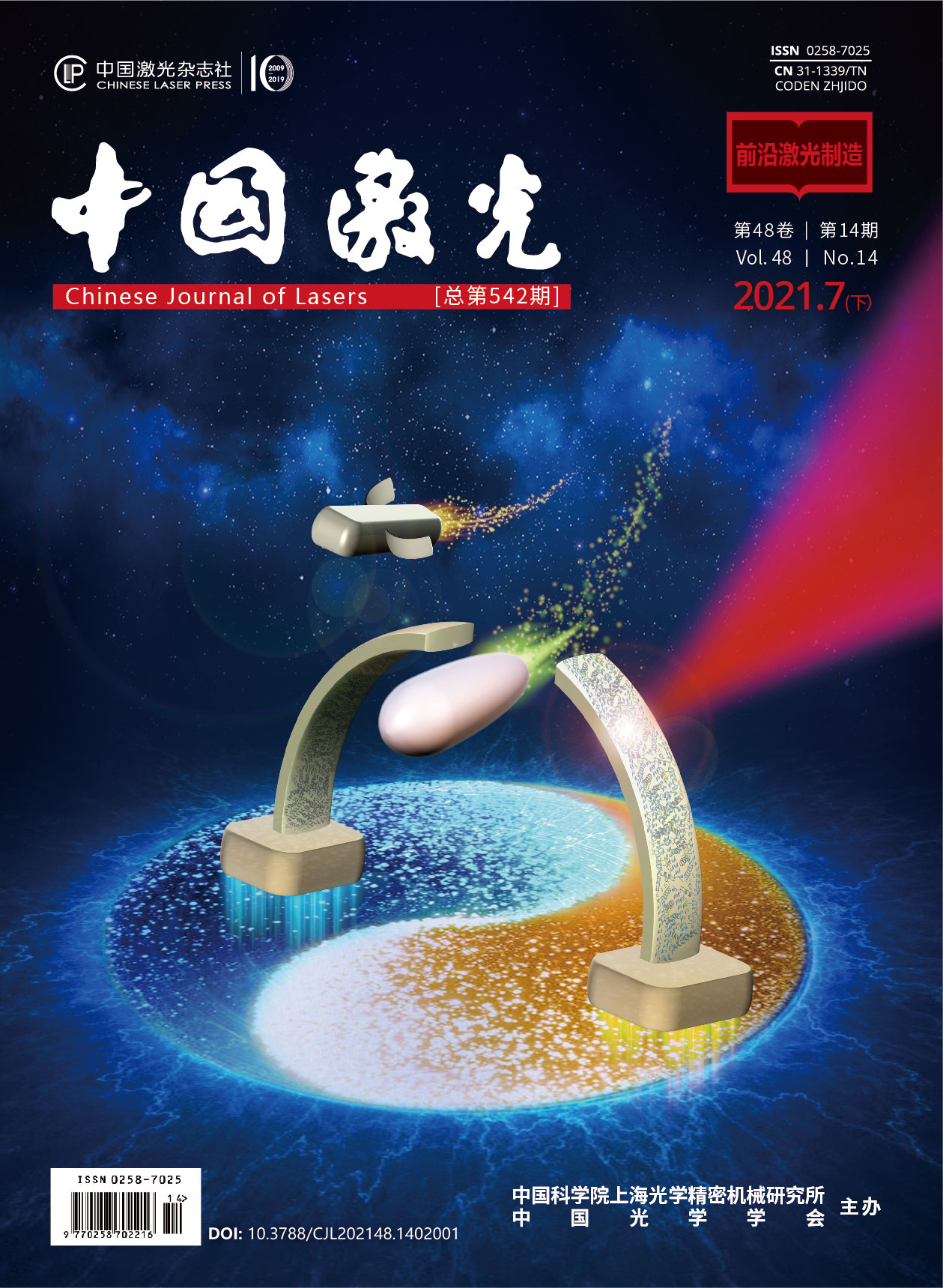纳秒激光辐照铝合金诱致颗粒物产生规律  下载: 668次
下载: 668次
Objective With the continuous advancement in laser-driven inertial confinement nuclear fusion research, laser damage to optical components caused by particle pollutants has become a bottleneck limiting the output capacity of high-power laser drivers. In a high-power laser system (HPLS), stray light and ghost spots can have a high energy density, and the surface of the mechanical components is easily exposed to stray light to produce metal particles, which diffuse into the optical path and result in a large number of aerosols. Aerosol pollutants can not only fill the gaps of the porous sol-gel coating on optical surfaces to reduce transmittance but also easily damage the optical element under laser irradiation. Therefore, suppressing particle pollutants is crucial to improve the output capacity of HPLSs. The aluminum alloy is commonly used as the mechanical component in high-power laser facilities; thus, we experimentally study the generation of aluminum alloy particles irradiated by a nanosecond laser in this article. The effects of laser parameters and sample surface treatments on particle generation are investigated in detail, and the suppression methods of particle generation are discussed to control online cleanliness in HPLSs.
Methods The nanosecond laser was passed through a window glass of the cavity to irradiate the surface of a metal sample with an incident angle of 0°. Clean nitrogen gas was continuously filled into the cavity through the gas inlet to remove particles generated by the laser radiation to exit the cavity through the exhaust hole at the back of the cavity. Because of the rapid gas flow rate from the cavity vent hole, the exhaust gas was divided into two parts: one part was directly discharged into the surrounding atmosphere, and the other part was fed into a particle counter to measure the number of the particles with various sizes. Therefore, the number of particles produced by laser irradiation in the experiment was 3.16 times that of data directly measured using the particle counter. Micron and submicron aerosol particle generation rules were compared for 5052 aluminum alloy samples treated with and without natural anodizing process. The effects of laser energy density, irradiation time, laser repetition frequency, laser spot area, and sample surface roughness were analyzed on the generated particles.
Results and Discussions When the laser energy density was higher than the ablation threshold, the number of particles generated on the natural anodized sample dramatically increased with laser energy density. The smaller the particle size, the more significant the growth effect. With the increase in the laser energy density, the number of different-sized particles in the non-natural anodized sample linearly increased; there was no jump increase in the number of particles (Fig. 4). With a 0.6 J/cm 2 laser energy density, in the four pulses within the first 2 s, the number of particles of the two samples was almost the same, and the number of particles produced with the laser radiation time of 10--40 s was approximately same (Fig. 6). With a 2.2 J/cm 2 laser energy density, with the increase in laser radiation time, there was an insignificant change in the number of particles generated on the non-natural anodized sample, but the number of particles of natural anodized sample continued increasing (Fig. 7). Under different laser repetition frequencies, the non-natural anodized sample had a similar distribution range of particles quantity, and the number of particles produced at the repetition frequency of 10 Hz was just slightly more than that produced at lower repetition frequency. However, for the sample with natural anodizing, the greater the laser repetition frequency, the greater the number of particles (Fig. 8). The ratio of the number of 0.3 μm particles produced on the non-natural anodized sample with 6 mm and 2 mm spot diameters was in the range of 7--40. In two experiments of the natural anodized sample, the ratio of the number of 0.3 μm particles was in the range of 3--16 (Fig. 10). The non-natural anodized sample with a surface roughness of Ra=3.2 μm produced considerably more particles than that with a roughness of Ra=1.6 μm, especially at a smaller laser energy density (Fig. 11). However, the surface roughness of natural anodized sample had an insignificant effect on particle generation.
Conclusions When 5052 aluminum alloy samples treated with and without a natural anodizing process were irradiated with a laser energy density lower than 0.8 J/cm 2, the number of particles was extremely small. With energy density higher than 0.8 J/cm 2, the number of particles produced in the natural anodized sample rapidly increased; there was a jump increase near the ablation threshold. By increasing the laser spot area, the number of particles could be considerably increased, and the number of particles generated in the natural anodized sample was proportional to the spot area. When the laser energy density was higher than the surface ablation threshold, the laser energy density was the most essential factor determining the number of generated particles. The non-natural anodized sample with a surface roughness of Ra=3.2 μm produced more particles than that with a roughness of Ra=1.6 μm and could excite numerous particles with a smaller laser energy density. Therefore, laser beams with small energy density can be used in a laser cleaning process. The natural anodized surface produced more particles than the untreated surface. So, optimizing the surface treatment of aluminum alloys to suppress particle generation is meaningful. Surface roughness strongly affected particle generation; thus, the requirements on the cost and cleanness control should be comprehensively considered to select a suitable surface roughness level.
李畅, 庞向阳, 孙明营, 刘文凤, 乔战峰, 朱健强. 纳秒激光辐照铝合金诱致颗粒物产生规律[J]. 中国激光, 2021, 48(14): 1402015. Chang Li, Xiangyang Pang, Mingying Sun, Wenfeng Liu, Zhanfeng Qiao, Jianqiang Zhu. Particles Generation of Aluminum Alloy Induced by Nanosecond Laser[J]. Chinese Journal of Lasers, 2021, 48(14): 1402015.







